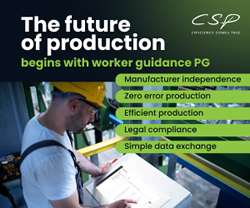The Value of Cloud Based Slicing and File Management for 3d Printing
A peek into Samsung's smart manufacturing
New 3-D printing method creates shape-shifting objects
Solving Complex Adhesion Problems with Plasma
A Deeper Look at "Precision" Toolholders
Belgian company takes 3D printing to chocolate
More production, more jobs? CMU pitches businesses on robotics in manufacturing
Game On: Augmented Reality Is Helping Factory Workers Become More Productive
IT Security and Machine Safety
Boeing turns to 3D-printed parts to save millions on its 787 Dreamliner
Siemens and Materialise Technology Integration Streamlines Product Design Through 3D Printing
Insert Molding vs Traditional Injection Molding
Protection - Arguments for Safer Working Environment
Manufacturers Achieve Safety and Employee Engagement of Spanish Speaking Workers
The Fourth Industrial Revolution: Technology alliances lead the charge
Records 2491 to 2505 of 3070
First | Previous | Next | Last
Featured Product

Quality assurance in the manufacturing industry
Manufacturing and Automation - Featured Company

